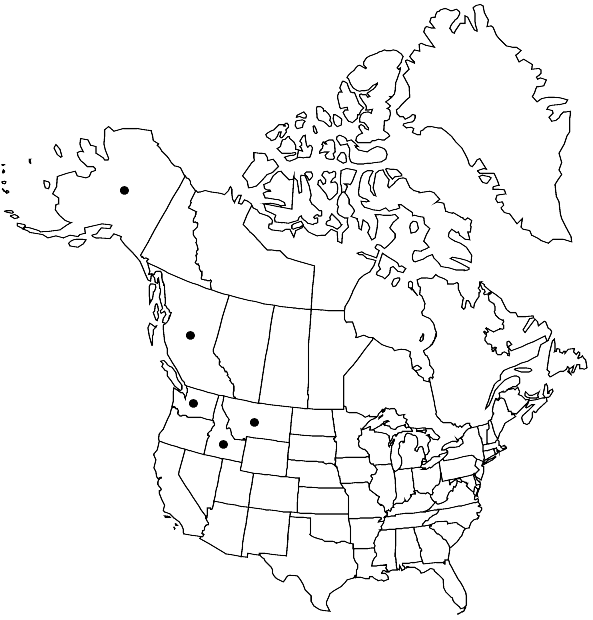Bucklandiella heterosticha
in R. Ochyra et al., Cens. Cat. Polish Mosses, 145. 2003,.
Plants medium-sized to fairly large, rather slender but rigid, in loose or dense tufts or extensive mats, often hoary, dull green to olivaceous distally, brown to blackish proximally. Stems 2–6 (–12) cm, prostrate to ascending, sparingly to copiously branched, often with numerous short branchlets. Leaves loosely imbricate, twisted or secund when dry, erect-spreading to patent when moist, lanceolate, channeled along the costa, (2–) 2.5–3.5 (–4.7) (with awns) × 0.6–0.9 mm; margins 1-stratose throughout with some 2-stratose spots distally, recurved on both sides towards the apex, sometimes strongly so on one side and usually less recurved on the other side; with a usually long, 0.5–1.5 (–3) mm, prominent, erect, hyaline awn, flattened, often decurrent, distinctly denticulate at the margins, often somewhat flexuose and wrinkled and spinulose on the back side; costa percurrent or subpercurrent, channeled adaxially throughout, rather weakly convex on the abaxial side, (60–) 80–110 (–150) µm wide near the base, (40–) 50–65 (–75) µm wide distally, 3–4-stratose with (4–) 5–9 (–11) larger adaxial cells at the base, 2 (–3) -stratose with (3–) 4–8 adaxial cells in mid leaf and 2-stratose distally with 2–4 (–5) adaxial cells; laminal cells 1-stratose, smooth or weakly bulging; basal laminal cells elongate, 15–35 × 8–10 µm, with thick, sinuous-nodulose walls; alar cells not or slightly differentiated, yellowish, sometimes forming a small group; supra-alar cells not differentiated; distal and medial laminal cells irregularly quadrate to rectangular, 10–25 × 8–10 µm, often becoming oblate at the margins in the distal part. Inner perichaetial leaves (1–4) hyaline, bluntly pointed, epilose. Seta brown, 4–9 mm. Capsule brown, somewhat glistening shortly cylindric, 15–30 × 0.5–0.8 mm; operculum with a long beak, to 1 mm; peristome teeth 250–380 µm, yellowish-brown, papillose, irregularly cleft into 2 or seldom 3 prongs distally, or undivided, only with median perforations, arising from a rather short, 35–50 µm high, basal membrance. Spores 14–18 µm.
Habitat: Acidic rocks, stones and boulders, rock outcrops and ledges, hillsides, cliffs, dry and exposed, less often shaded and damp sites, occasionally on sandy soil or thin soil accumulated on rock faces
Elevation: low to high elevations (0-2000 m)
Distribution

B.C., Alaska, Idaho, Mont., Wash., Europe, Atlantic Islands (Azores), Atlantic Islands (Canary Islands), Atlantic Islands (Iceland), Atlantic Islands (Madeira)
Discussion
Bucklandiella heterosticha is a core species of a complex of several more closely or remotely related taxa which have been interpreted variously in the past. Consequently, depending on the taxonomic interpretation, the global range of this species has been variously defined. As presently conceived, B. heterosticha is characterized by a combination of several stable characters, including strongly modified, entirely hyaline innermost perichaetial leaves; broad costa that is canaliculate throughout the adaxial side and moderately convex on the abaxial surface, with as many as 5–9 enlarged cells on the adaxial side in the basal part; sinuose-nodulose, moderately thick-walled basal leaf cells; undifferentiated alar cells and basal marginal border; 1-stratose leaf margins with occasional 2-stratose spots distally that are recurved to the apex, at least on one side, and long, erect, and weakly flexuose awns that are strongly flattened and low-denticulate and spinulose. As so defined, B. heterosticha is confined to the Pacific Northwest, where it occurs throughout the Aleutian Islands, along the coastal regions southwards to Oregon, and to Montana in the Rocky Mountains.
Bucklandiella heterosticha is closely related to and most likely to be mistaken for B. affinis, with which it shares its western North American range. Although both species differ by their gross morphology, B. heterosticha being grayish green and B. affinis a more yellowish green, the safest characters discriminating these species are the costal anatomy. Bucklandiella heterosticha has a canaliculate costa that is 2-stratose in the middle and in the lower distal part, whereas in B. affinis the costa is 3-stratose in the same portions and is more convex on the abaxial side. Bucklandiella sudetica is different from B. heterosticha in its shorter capsules, narrower leaf with shorter awns, costal anatomy, and undifferentiated innermost perichaetial leaves. Bucklandiella pacifica is distinct in its consistently epilose leaves and from muticous ecads of B. heterosticha in having distinctly keeled costa in the distal part. Bucklandiella obesa is a strikingly more robust plant, less branched than B. heterosticha, and has both shorter awns and seta.
Selected References
None.
Lower Taxa
"-stratose" is not declared as a valid unit of measurement for this property.